My SAQA Oceania Square
 Monday, August 26, 2013 at 07:03PM
Monday, August 26, 2013 at 07:03PM Desert Finds
I started my square by stretching fabric lightly between two frames in my backyard on a sunny day and painting it. I wanted a warm colour - like the silky sand that our feet slipped into as we walked, sometimes up to our ankles on the dunes. At the end of our fifteen day trip across the Sahara our feet were polished and smooth - I do not think they will ever look like that again.
The paint is HiLo and I really love it. I do not try to paint specific things with hard edges - but for colour backgrounds it is perfect. I blend as I go, I work with the fabric damp, I tinge pure colour with a few drops of black to make it feel more natural, and occasionally flick other colours into it while it is still wet. I also painted greys and blacks so I had fabric I could cut and piece.
Then I started having fun. I cut a piece to use as a background. As we travelled we had found wonderful tools - in most of the areas where we stopped. We had a rule - 'one thing a day could be picked up' as we wanted to leave the desert as close as possible to the way we found it.
I used Tsukineko inks and their stick applicators to draw out my small tools. I used several techniques for this - I sketched first in pencil and filled in completely in colour and I also left some as line drawings. I worked briefly with archaeologists when living in Jordan so I had drawn up some images with them and knew the conventions that many use to imply shadows - though my drawing process was quick and dirty in comparison.
I drew four small tools. I am really fascinated with these - rocks that have been in the region since the earth formed, altered and shaped by people from long ago. I feel that when I reach down to pick up a small piece I am the first person to touch it since that hand - probably more than 9,000 years ago, dropped it and lost it, or discarded it as not quite good enough.
I wanted another darker reference as a lot of the driving we did was over black rock, sometimes sharp edged, sometimes wind shaped and rounded, and the sand slid down in the cracks.
I found some pinwhale corduroy which bleaches gold and put pebbles on it, then lightly sprayed it with bleach. I let that sit in the sun until the colour looked interesting.
At around that point I completely forgot that I was supposed to be photographing my process and sewed it together and quilted it - so I am treating each section separately here.
I quilted around my rocks and put curves like contours in the backgrounds.
I pieced my favourite strip-pieced crosses to stand for the grids an archaeologist puts on the earth before and during the cutting process, and I quilted those in the ditch.
The sharp change between the pale gold of the sand and the darkness of the corduroy worried me. I knew that I was going to fix that and soften the edge - so I found my few remaining sticks of D'Uva Lithocoal. If anyone has this in a back room - I will buy it! Please. It is wonderful. It is a heat-fixable charcoal that acts like a willow charcoal. It is light and powdery when applied and will just fall off if you tip it so I work on an ironing board and draw, then cover with baking paper or parchment and iron it - and it is permanent.
That is definitely better. The charcoal picks up the high points of the quilting, and leaves light colour in the ditch, just as sand fell between the rocks.
I quilted my greys from the handpainted fabric in contours, to reference mapping.
I did not like the fact that one cross that looked prominent was cut off - so I quilted it in and painted it gold, then added more gold crosses.
I face my work instead of binding it - I like the way a facing is quick and easy, but I also feel that it is more contemporary for art quilts - it gives a sleek edge and work goes right to the edge to inply that continuation beyond.
A sneak peek at the back - also painted fabric.
And it is finished. Desert Finds, by Jenny Bowker
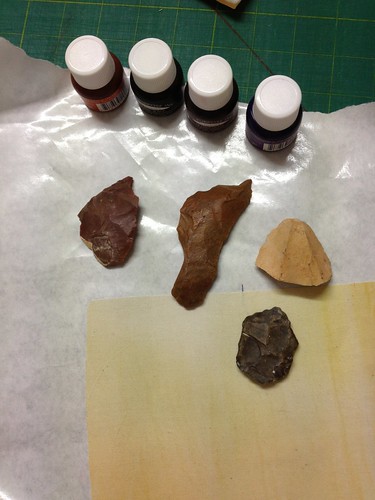
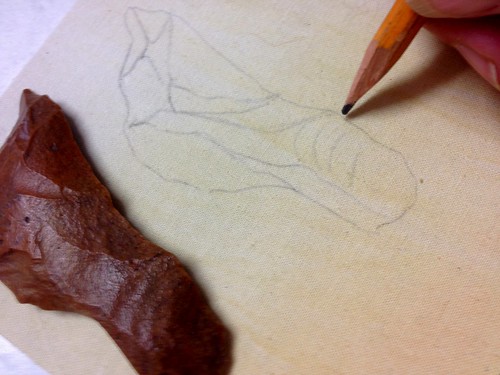
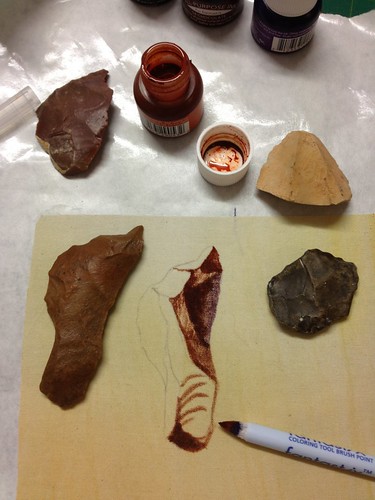
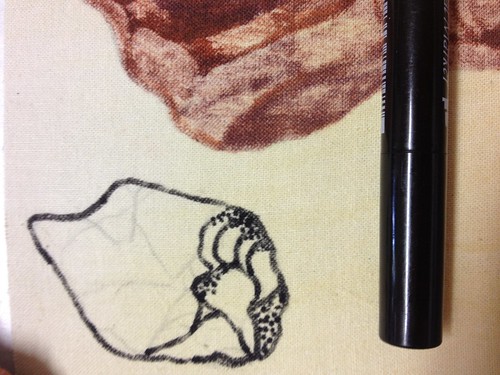

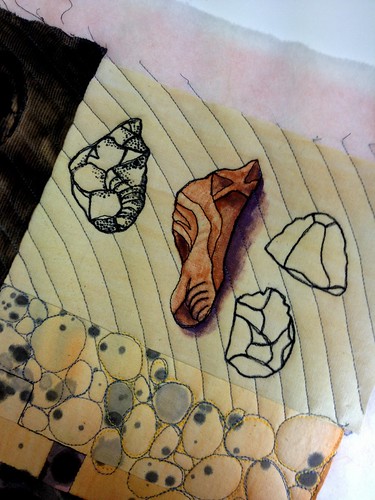
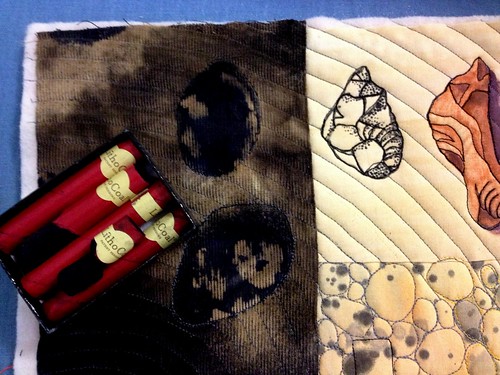
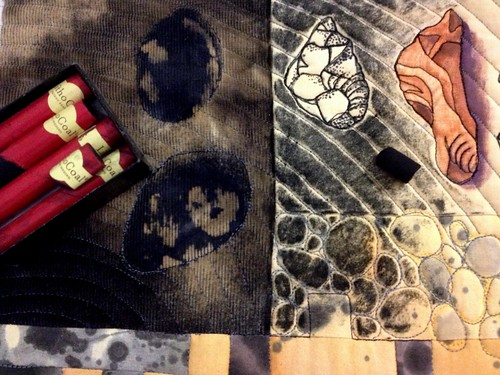
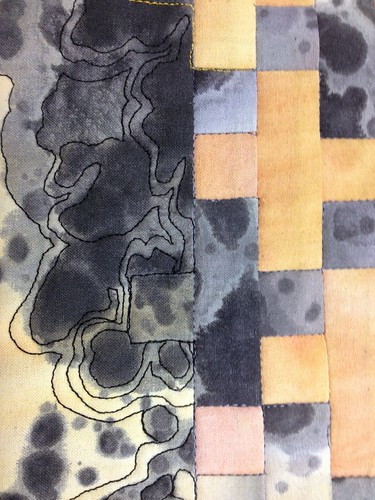
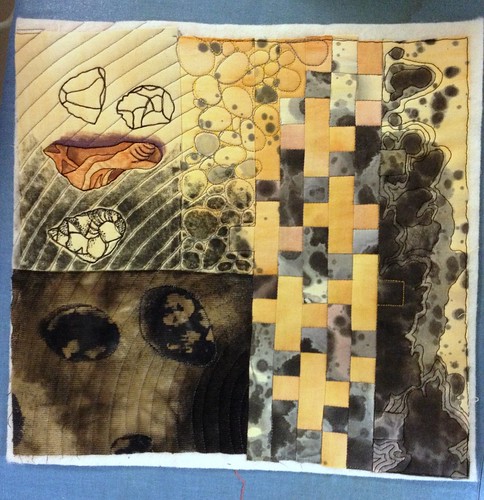
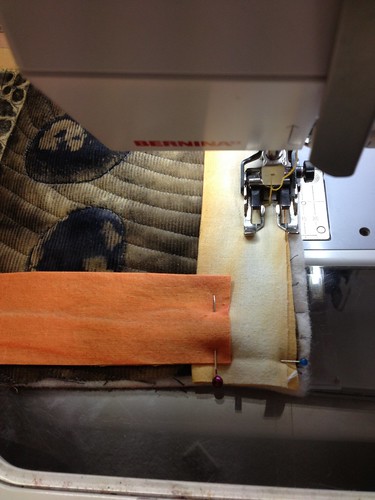
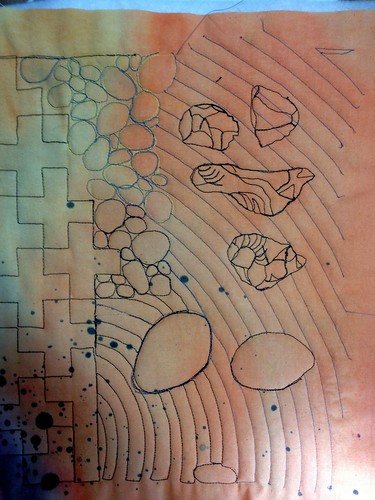
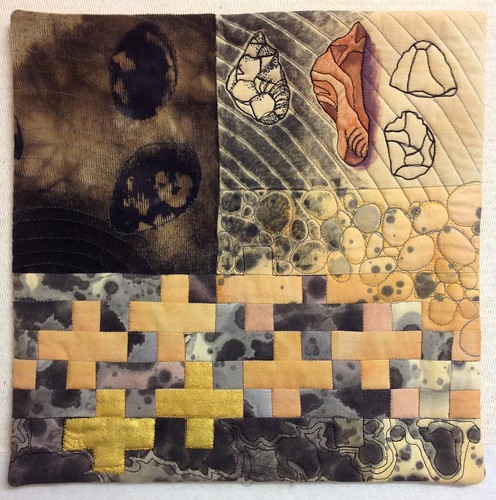
Reader Comments (5)
Thank you for describing your design process. It was like a mini tutorial. Learnt something. Also loved your piece.
Hi Jenny,
lovely piece and great tutorial.
I also hoard my D'UVA chromacoal powders, I have a set of color sticks and a set of colored powders that I'm almost reluctant to use since I know once they're gone they're gone. I emailed the guy who made the product about 6 or 7 years ago when I couldn't find any to order. Turns out he was a university printmaking instructor who had come up with the products and couldn't keep up with production on them and wanted to get one of the big art stores to pick up the product line for production, but I guess they just didn't see enough of a market. Sadly for us, they are so amazing for textiles.
judy
Thank you for showing your process, Jenny. I could hear your voice in the writing and felt your passion for the piece. Very inspirational
Linda
Thanks for sharing Jenny. It's a lovely piece and interesting to find out more about the process and thoughts behind it.
I attended your lecture at the Taupo Symposium and I think it was the best one - well put together, great slides and fantastic anecdotes.
Never heard of the chromacoal stuff, but it sounds like something I'd love to play with!
I love your work Jenny, so completely organic from beginning to end, yet eloquent and refined.